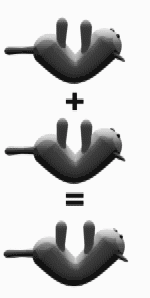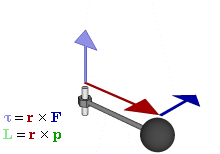 W
WA rotation is a circular movement of an object around a center of rotation. The geometric plane along which the rotation occurs is called the rotation plane, and the imaginary line extending from the center and perpendicular to the rotation plane is called the rotation axis. A three-dimensional object can always be rotated about an infinite number of rotation axes.
 W
WIn physics, the concept of absolute rotation—rotation independent of any external reference—is a topic of debate about relativity, cosmology, and the nature of physical laws.
 W
WAn ambigram is a calligraphic design that has several interpretations as written.
 W
WIn physics, angular momentum is the rotational equivalent of linear momentum. It is an important quantity in physics because it is a conserved quantity—the total angular momentum of a closed system remains constant.
 W
WA rotating black hole is a black hole that possesses angular momentum. In particular, it rotates about one of its axes of symmetry.
 W
WWalt Disney's Carousel of Progress is a rotating theater audio-animatronic stage show attraction that is located in Tomorrowland at the Magic Kingdom theme park at the Walt Disney World Resort in Bay Lake, Florida just outside of Orlando, Florida. Created by both Walt Disney and WED Enterprises as the prime feature of the General Electric (GE) Pavilion for the 1964 New York World's Fair, the attraction was moved to Tomorrowland at Disneyland in Anaheim, California as Carousel of Progress, remaining there from 1967 until 1973. It was replaced in Disneyland by America Sings in 1974, and reopened in its present home in the Magic Kingdom in 1975.
 W
WIn Newtonian mechanics, the centrifugal force is an inertial force that appears to act on all objects when viewed in a rotating frame of reference. It is directed away from an axis which is parallel to the axis of rotation and passing through the coordinate system's origin. If the axis of rotation passes through the coordinate system's origin, the centrifugal force is directed radially outwards from that axis. The magnitude of centrifugal force F on an object of mass m at the distance r from the origin of a frame of reference rotating with angular velocity ω is:
 W
WIn geometry, circular symmetry is a type of continuous symmetry for a planar object that can be rotated by any arbitrary angle and map onto itself.
 W
WIn physics, the Coriolis force is an inertial or fictitious force that acts on objects that are in motion within a frame of reference that rotates with respect to an inertial frame. In a reference frame with clockwise rotation, the force acts to the left of the motion of the object. In one with anticlockwise rotation, the force acts to the right. Deflection of an object due to the Coriolis force is called the Coriolis effect. Though recognized previously by others, the mathematical expression for the Coriolis force appeared in an 1835 paper by French scientist Gaspard-Gustave de Coriolis, in connection with the theory of water wheels. Early in the 20th century, the term Coriolis force began to be used in connection with meteorology.
 W
WA revolving door typically consists of three or four doors that hang on a central shaft and rotate around a vertical axis within a cylindrical enclosure. Revolving doors are energy efficient as they prevent drafts, thus decreasing the loss of heating or cooling for the building. Revolving doors were designed to relieve stack effect pressure in buildings. High-rise buildings experience immense pressure caused by air rushing through the building, referred to as 'Stack Effect' pressure. At the same time, revolving doors allow large numbers of people to pass in and out.
 W
WEarth's rotation is the rotation of planet Earth around its own axis. Earth rotates eastward, in prograde motion. As viewed from the north pole star Polaris, Earth turns counterclockwise.
 W
WAn Eskimo yo-yo or Alaska yo-yo is a traditional two-balled skill toy played and performed by the Eskimo-speaking Alaska Natives, such as Inupiat, Siberian Yupik, and Yup'ik. It resembles fur-covered bolas and yo-yo. It is regarded as one of the most simple, yet most complex, cultural artifacts/toys in the world. The Eskimo yo-yo involves simultaneously swinging two sealskin balls suspended on caribou sinew strings in opposite directions with one hand. It is popular with Alaskans and tourists alike. This traditional toy is two unequal lengths of twine, joined together, with hand-made leather objects at the ends of the twine.
 W
WThe falling cat problem is a problem that consists of explaining the underlying physics behind the observation of the cat righting reflex: that is, how a free-falling body can change its orientation such that it is able to right itself as it falls to land on its feet, irrespective of its initial orientation, and without violating the law of conservation of angular momentum.
 W
WThe rotation curve of a disc galaxy is a plot of the orbital speeds of visible stars or gas in that galaxy versus their radial distance from that galaxy's centre. It is typically rendered graphically as a plot, and the data observed from each side of a spiral galaxy are generally asymmetric, so that data from each side are averaged to create the curve. A significant discrepancy exists between the experimental curves observed, and a curve derived by applying gravity theory to the matter observed in a galaxy. Theories involving dark matter are the main postulated solutions to account for the variance.
 W
WInner core super-rotation is a true eastward rotation of the inner core of Earth relative to its mantle, for a net rotation rate that is faster than Earth as a whole. A 1995 model of Earth's dynamo predicted super-rotations of up to 3 degrees per year; the following year, this prediction was supported by observed discrepancies in the time that p-waves take to travel through the inner and outer core.
 W
WThe instant center of rotation, also called instantaneous velocity center, or also instantaneous center or instant center, is the point fixed to a body undergoing planar movement that has zero velocity at a particular instant of time. At this instant, the velocity vectors of the other points in the body generate a circular field around this point which is identical to what is generated by a pure rotation.
 W
WMagnetic braking is a theory explaining the loss of stellar angular momentum due to material getting captured by the stellar magnetic field and thrown out at great distance from the surface of the star. It plays an important role in the evolution of binary star systems.
 W
WThe moment of inertia, otherwise known as the mass moment of inertia, angular mass or rotational inertia, of a rigid body is a quantity that determines the torque needed for a desired angular acceleration about a rotational axis; similar to how mass determines the force needed for a desired acceleration. It depends on the body's mass distribution and the axis chosen, with larger moments requiring more torque to change the body's rate of rotation.
 W
WParbuckle salvage, or parbuckling, is the righting of a sunken vessel using rotational leverage. A common operation with smaller watercraft, parbuckling is also employed to right large vessels. In 1943, the USS Oklahoma was rotated nearly 180 degrees to upright after being sunk in the attack on Pearl Harbor, and the Italian cruise ship Costa Concordia was successfully parbuckled off the west coast of Italy in September 2013, the largest salvage operation of that kind to date.
 W
WThe rotation period of a celestial object is the time that the object takes to complete a single revolution around its axis of rotation relative to the background stars. It differs from the object's solar day, which may differ by a fractional rotation to accommodate the portion of the object's orbital period during one day.
 W
WIn physics, relativistic angular momentum refers to the mathematical formalisms and physical concepts that define angular momentum in special relativity (SR) and general relativity (GR). The relativistic quantity is subtly different from the three-dimensional quantity in classical mechanics.
 W
WRolling is a type of motion that combines rotation and translation of that object with respect to a surface, such that, if ideal conditions exist, the two are in contact with each other without sliding.
 W
WA rotating frame of reference is a special case of a non-inertial reference frame that is rotating relative to an inertial reference frame. An everyday example of a rotating reference frame is the surface of the Earth.
 W
WRotation around a fixed axis is a special case of rotational motion. The fixed-axis hypothesis excludes the possibility of an axis changing its orientation and cannot describe such phenomena as wobbling or precession. According to Euler's rotation theorem, simultaneous rotation along a number of stationary axes at the same time is impossible; if two rotations are forced at the same time, a new axis of rotation will appear.
 W
WRotational spectroscopy is concerned with the measurement of the energies of transitions between quantized rotational states of molecules in the gas phase. The spectra of polar molecules can be measured in absorption or emission by microwave spectroscopy or by far infrared spectroscopy. The rotational spectra of non-polar molecules cannot be observed by those methods, but can be observed and measured by Raman spectroscopy. Rotational spectroscopy is sometimes referred to as pure rotational spectroscopy to distinguish it from rotational-vibrational spectroscopy where changes in rotational energy occur together with changes in vibrational energy, and also from ro-vibronic spectroscopy where rotational, vibrational and electronic energy changes occur simultaneously.
 W
WA rotating wheel space station, also known as a donut city or a von Braun wheel, is a concept for a hypothetical wheel-shaped space station. Originally proposed by Konstantin Tsiolkovsky in 1903, the idea was expanded by Herman Potočnik in 1929.
 W
WStellar rotation is the angular motion of a star about its axis. The rate of rotation can be measured from the spectrum of the star, or by timing the movements of active features on the surface.
 W
WA synestia is a hypothesized rapidly spinning doughnut-shaped mass of vaporized rock. In computer simulations of giant impacts of rotating objects, a synestia can form if the total angular momentum is greater than the co-rotational limit. Beyond the co-rotational limit, the velocity at the equator of a body would exceed the orbital velocity. In a synestia, this results in an inner region rotating at a single rate with a loosely connected torus orbiting beyond it. Synestias also have differences in the mantles, both thermally and in their composition, from previous terrestrial evolution models due partially to a lower interior pressure.
 W
WIn physics and mechanics, torque is the rotational equivalent of linear force. It is also referred to as the moment, moment of force, rotational force or turning effect, depending on the field of study. The concept originated with the studies by Archimedes of the usage of levers. Just as a linear force is a push or a pull, a torque can be thought of as a twist to an object around a specific axis. Another definition of torque is the product of the magnitude of the force and the perpendicular distance of the line of action of a force from the axis of rotation. The symbol for torque is typically , the lowercase Greek letter tau. When being referred to as moment of force, it is commonly denoted by M.
 W
WIn fluid dynamics, a vortex is a region in a fluid in which the flow revolves around an axis line, which may be straight or curved. Vortices form in stirred fluids, and may be observed in smoke rings, whirlpools in the wake of a boat, and the winds surrounding a tropical cyclone, tornado or dust devil.